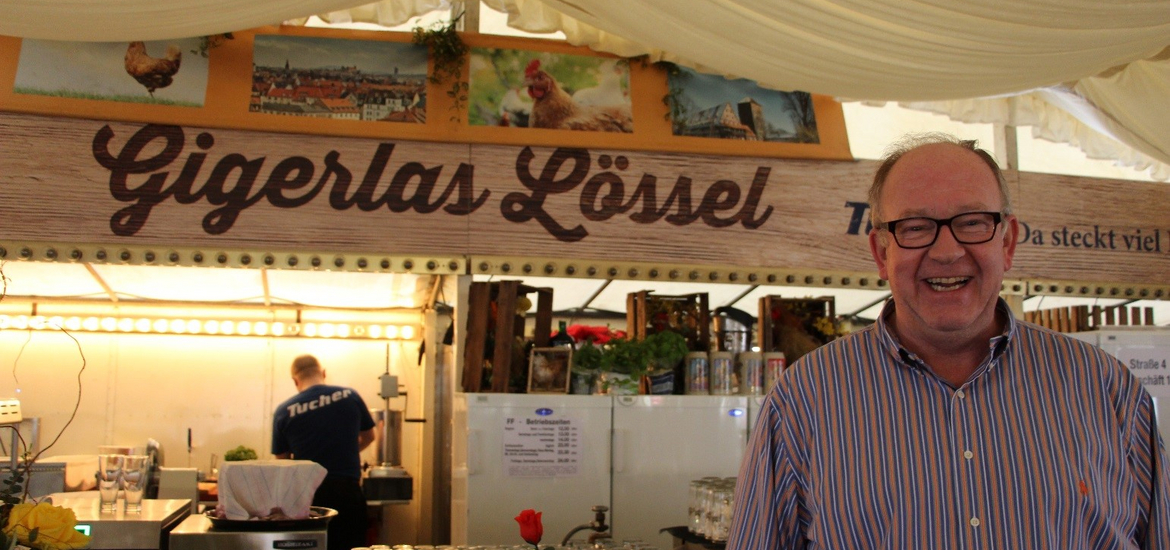The head of the restaurant, Peter Lössel, arrives in a moment and greets with a smile, welcoming me to his traditional tent at the Nuremberg Fair. I watch with interest the activity in the Gigerlas tent. While the rest of the fairgrounds seem still asleep, busy workers are scurrying about in every corner of the tent, preparing for the day to come: Some are sweeping, others putting up tables, dead lightbulbs are exchanged for new and uneven spots in the flooring made straight. Peter Lössel calls this with humor "internal- and external-cosmetics". This routine takes place every day for him and his nine co-workers. With temporary staff and waiters, he employs a total of 28. The permanent employees sleep, as customary, in trailers on the fairgrounds. Currently, the Lössel family is forced to drive home each evening, as their camper was damaged in a fire. As soon as the new caravan is complete, they will again spend day and night at the fairgrounds.
In contrast to other establishments at the fair, Peter Lössel opens his doors at 12 noon. When asked if the tent is busy in the afternoon, mindful of tradition, he says:" Anyone who comes shouldn’t be disappointed". He knows how to appreciate his regular guests and is even willing to provide a sausage breakfast before opening hours for families who are friends.
As the day’s fresh meat arrives, I get to enjoy a culinary look behind the scenes. Today, together with Peter Lössel, I get to watch his favorite chili bratwurst being made. One sees at once that the freshly-delivered meat is of the best quality: It is tender, has a small amount of fat and a very healthy color. "There has to be a little fat, otherwise there would be nothing in the sausage to carry the flavor", says Lössel. The delivery has barely arrived when he rolls up his sleeves and begins immediately with the production of the chili bratwurst. This runs parallel to the creation of the "normal" Franconian sausages. With practiced movements, he reaches for the necessary spices, which he weighs one by one on a small scale: salt, pepper, sugar, marjoram, nutmeg and caraway. "Some people add a lot more things to their sausages", says Lössel. But he works on the principle "less is more", because too many spices spoil the original flavor of the meat.
One of his employees then mixes the spices with the meat, which is then put through a grinder and minced. What is remarkable is that every step takes place by hand. Every individual piece of meat is put in the grinder. And then the mass of ground meat is mixed again by hand – a procedure that takes a lot of muscle. Why bother? "Because in an industrial mixer, the mass will be squeezed together more and less air will remain", explains Lössel. The mixing procedure is a very important step, which has to be done carefully, because if the spices are not evenly distributed in the minced meat, one guest will get a sausage that is too spicy and the next a bratwurst without flavor. Part of the mass is then set aside for the chili bratwurst.
Parallel to this action, an employee cuts chilies – half are spicy and the other half mild – into ultra-fine pieces. It’s not difficult to guess that these are for the chili bratwurst. "If we used only spicy chilies, the sausages would be much too hot. But to have enough pepper pulp in the meat, we add mild into the mix". The finely sliced chili peppers are now careful mixed into the ground meat. This must be mixed well a second time, otherwise one sausage might be too spicy, the next too mild. Through this fruit pulp, the mass becomes juicier, which produces a sausage that is denser than the traditional Franconian bratwurst.
In the next step, the meat used to fill the casings, creating individual sausages. Naturally, Lössel doesn’t use just any casing, but a special pig’s intestine which is especially fine and contains a line of fat, so that the flavor of the sausage meat is enhanced. "Naturally this type of casing is more expensive than a normal pig’s intestine, but we want to offer our customers only the best, which they’ve come to expect from us over generations", explains Lössel. With a practiced hand, he feeds the casing on the sausage machine and forms individual chili bratwurst. Again, this is all done by hand, as it creates a better consistency of sausage. Machine-pressed sausages become too dense.
But how did Peter Lössel get the idea of making a chili bratwurst along with the traditional Franconian? Six years ago, he was a guest on a television cooking show. The TV chef found "normal" bratwurst too boring and came up with the idea of chili bratwurst. At the end of the show, Lössel found the sausage so delicious he decided to add them to his menu. Because the chili bratwurst had appeared on television, there was a demand for them right from the start.
Once the sausages have been formed, it’s just a short step before they appear on a plate for guests in Gigerlas Lössel: They are fried in a pan. While Nuremberg bratwurst are traditionally grilled over a beech-wood fire, it’s important to prepare Franconian sausage in a pan, says Chef Lössel. And here he has yet another innovation: His sausages are not fried in oil, but in custom-made lard from the best flare fat – a special fat which protects the pig’s organs from cold.
It’s not only guests to the fair which are happy about the delicious result of his bratwurst production, but the boss himself. He says that every time he smells a fresh pan frying, his mouth waters. No wonder, when there’s so much attention to craftsmanship and quality!
